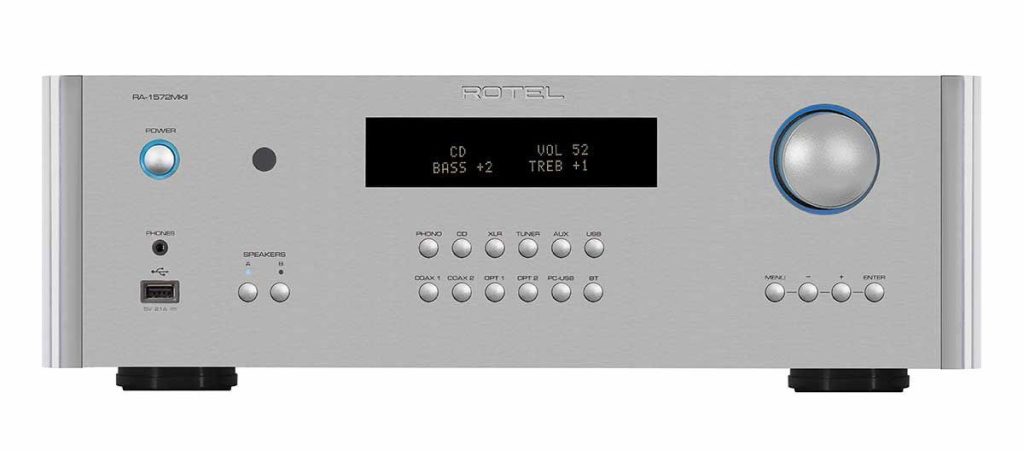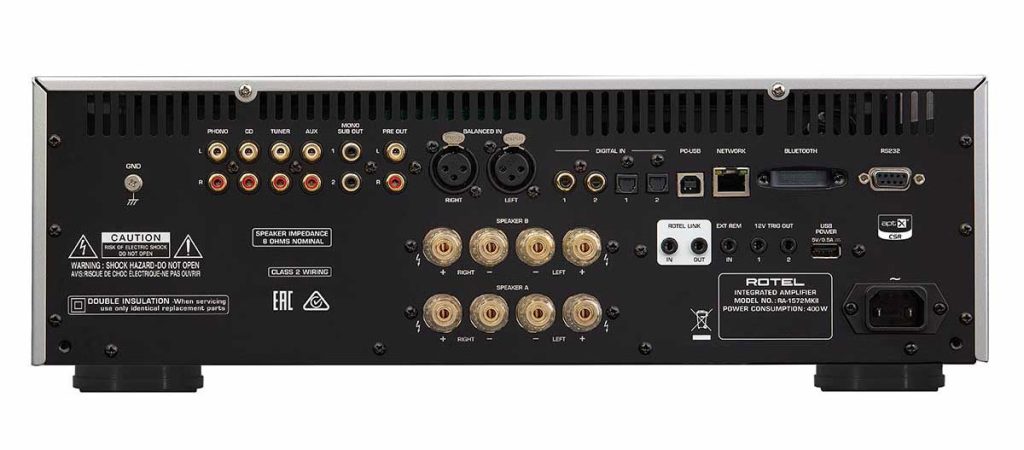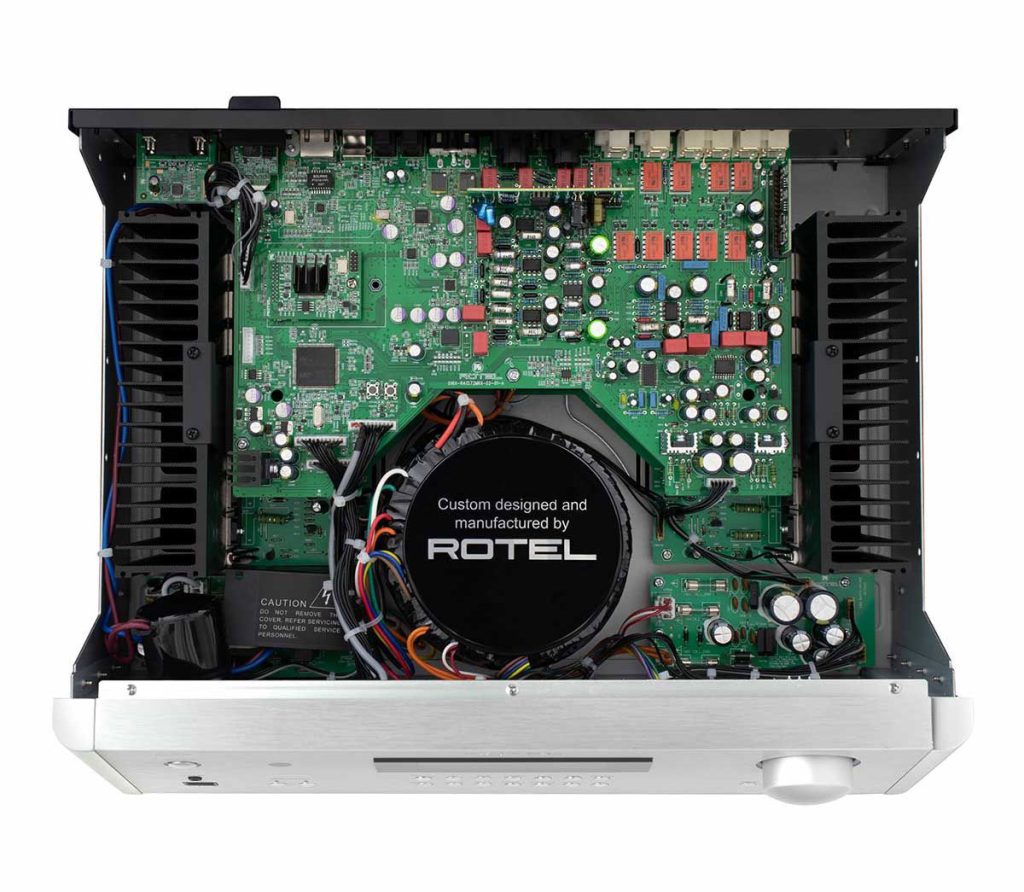As I look back, it has been a number of years since I have evaluated a Rotel Audio component. "The Rotel corporation grew from the efforts of one family's love of music." The company was launched some 60 years ago in, 1961. Today Rotel has launched an assault on the high end with their top-of-the-line Michi series of components. The "best-of" circuit topology, power supply design, methods, and component improvements were trickled down from the all-out Michi design effort. The MKII Michi derived upgrades include circuit redesign innovations, improved circuit topology, power supply redesign, and components that are selected for each application in key circuit locations. The Michi upgrades are now included in the RA 1572 MKII model. All the Rotel MKII integrated amplifiers have received new Digital-to-Analog (DAC) chips from Texas Instruments. "These design upgrades and sonic improvements were derived from engineering efforts that were three years in the making."
First look
The new 1572 MKll receiver is Rated at 120-watts for each channel, driven into an 8 Ohm speaker, and rated at 200-watts into a 4 Ohm speaker. The manufacturer's suggested retail price is 2099.99.
The RA 1572 MKII weighs 30 pounds and is housed in a very attractive satin finished aluminum case measuring, 17" wide, 12" deep, and 5 1/2" high. Most of the receiver's top cover has a series of slots for ventilation.
The owner's manual has information in four languages, and is contained on a CD supplied with the receiver. The front panel location and function of the user controls on the CD, in my opinion, is not made clear. So I have listed these controls for clarity.
The remote control has 51 buttons; some of them duplicate the control functions of the receiver. However, most of them are not directly related to the RA 1572 MKII. The handheld remote works perfectly, but most of the time I use the front panel buttons to make selections.
Front panel
Left to right side, On/Off button, Rremote sensor for a hand-held remote control, florescent dsplay, a large volume control knob. Just below, headphone jack, USB jack for cell phone, side by side speaker select, for A or B speakers,
The input source select is an array of 12 push buttons. There are two rows of six buttons.
The top row selects Phono, CD, XLR, Tuner, Aux, USB input.
The bottom row selects, Coax 1, Coax 2, Opt. 1, Opt. 2, PC USB, BT. On the same level at the extreme right side are four more push buttons designated as; Menu, Minus, Plus, Enter. These are displayed illumination and tone control settings.
The Rotel RA 1572 Mkll can replay audio files from your computer. It is certified Roon tested, supports MQA, wireless aptX, and AAC Bluetooth.
Printed on the shipping box is a notice that states, "this receiver is equipped with an accessory made specifically for iPhone and iPod." Unfortunately, I have an Android device. The Rotel receiver's PC-USB driver needs to be installed if you wish to replay sound files with sample rates above 96kHz, and up to 384kHz. The Rotel receiver can accept a variety of high-level sources.
Rear Panel
Around the back, there is a choice of high-level input and output connections. Notably, there are connections for two sets of speakers. Just two of these will be used by my stereo reference system. One of these is the subwoofer-out connection. The Rotel receiver can accommodate just about any source you might have.
For my evaluation, I have my SOTA turntable connected, my Sangean digital tuner, a Sony SACD player, a Yamaha XC50 wireless streamer, and a Music Hall DAC with a headphone amplifier.
On the inside
Internally, Rotel has made improvements to the highly regulated power supply and to the signal paths, including the coupling capacitors in and around the DAC stage. The circuits employ high-quality metal film resistors and polystyrene or polypropylene capacitors in the signal paths. The capacitors are high efficiency, low ESR slit-foil capacitors. The printed circuit boards are redesigned with balanced circuit traces that better maintain signal timing. Rotel manufactures their own toroidal transformers in house. An upgraded Texas Instruments (Burr-Brown) digital converter chip has been added. It will be able to process and display MQA and MQA Studio audio files and will work with 32-bit, 384kHz resolution. The Rotel receiver has the ability to replay audio files from your computer. The Rotel PC-USB driver needs to be installed if you wish to replay sound files with sample rates above 96kHz, up to 384kHz. For this evaluation, I did not use files with these higher sample rates.
My audition was done with the receiver's tone controls bypassed. For clarity every source component in my system was disconnected from my reference system and fed directly into the Rotel receiver. There was one exception, namely the Music Hall DAC which requires an input signal.
Listening
I used my Sangean digital tuner, a Sony SACD player, a Yamaha XC50 wireless streamer, and a Music Hall DAC. However, I anticipate the best of my test will be my very sensitive SOTA turntable setup as I was particularly curious how the Rotel phono amplifier would perform. The Rotel will only accept a Moving Magnet cartridge with the load set at 47k Ohms. Of my 10 cartridges, the Shure V-15 type 3 VMR has a 3.5 mv, output and should be an ideal match. Last November, while attending the Capital Audiofest, I purchased a mint vinyl Beach Boys album titled, The Sounds of Summer (Capital-8042219-01). Listening to the track "Good Vibrations," the treble sounds very clean, dynamic, and extended. It is so clear that you can separate the difficult first and second tenors mixed harmonies. The fact is, Rotel has turned out a super detailed phono stage. (I love vocal harmony).
The Music Hall 25.4 DAC operates with a separate input. But I want to mention it because it is capable of upsampling a Red Book 16-bit/44.1kHz bit-rate to a higher resolution 96kHz or to 192 kHz sampling rates. I connected my DAC to the Rotel receiver with four different cable types; XLR, RCA, S/PDIF, and TosLink. When I input both of these higher sampling rates, I found the Rotel receiver had no problems playing any of them back.
Let's listen to my Sony UHP-H1 and my reference CD Basia, Time And Tide (EK 40767). The Sony player was connected directly to the Rotel receiver's inputs in three different ways. First with S/PDIF coaxial, then stereo RCA, and last TosLink optical cable. All sounded super clear, but I believe the optical connection was slightly more dynamic. The first music track is "Promises." The opening starts with the music seemingly in the distance between the speakers and it gradually grows closer. This produces an effect like an optical zoom. It expands and moves closer until it fills the space between the speakers. The vocal line is, "Promises we forget about our promises." This passage is accompanied by a driving bass line. The bass is clean and powerful, imbued with pure excitement and enough power to wake up the neighbors.
I can't stop the audition here. I hooked up my Yamaha WXC 50 Blue-Ray amplifier and receiver. It operates on a Pandora Blue Ray music stream. The Yamaha receiver has three output connections like the Sony CD player. Again I used the RCA, optical, and coaxial connections. With every song streamed through the Yamaha, the sound was indistinguishable from my reference setup. Again, I preferred by a small margin, just like the Sony hook up, the sound of the optical (TosLink) connection.
In the final analysis, I have one small nit to pick, and it concerns the volume control. The Rotel volume control is a digital encoding type. It has no detents and no beginning or ending points. It requires large rotational movements to effect small changes. There is a limited tactile sense of control with no reference point for minimum or maximum volume. I would prefer a more conventional volume control.
Conclusions
The Rotel receiver functions like a telephone switchboard in a large corporation. You have a wide choice of content and control over what you listen to. Every single source I inputted to the Rotel performed flawlessly. I believe if it has any limits you will find them upstream in the quality of the signals you feed it. I have spent far more money over the years following the audiophile cult of separate components. True, there once was a time when that made far more sense. However I can see now how that rationale has faded with time and newer technology.
When I consider the flexibility performance and the price of $2099.99, I find it impossible not to recommend the RA 1572 MKII. (FYI, The US imposes tariffs on 66% of China's imports, averaging 19%.) Especially if you consider that you could spend far more buying one meter of cable. Consider it as the central brain of a smaller high end music system. I found that the venerable Rotel corporation has not rested on some older technology. And I am so very glad that the escalating cost of a good music system has not slammed the door on music lovers. Today it stands side by side among the ranks of affordable high-end audio manufacturers.
My motto, Semper Hi-Fi
Specifications
- Power Output: 200 watts (4 ohms), 120 watts (8 ohms) <0.018% THD)
- Dimensions: (WxHxD, Inches) 17. X 5.6 X 14.15
- Weight: (Pounds) 30
- Inputs: Coaxial digital (2), optical digital (2), analog stereo RCA (4), balanced XLR, MM phono; USB type-B, USB type-A (front panel)
- Outputs: stereo speaker level (dual, paralleled multiway binding posts), analog stereo RCA pre-out, mono subwoofer out, headphone (1/4-in. stereo, front panel)
- Wireless: Bluetooth aptX
- Additional: RJ-45 (Ethernet) port (control only), RS-232- serial, IR input, 12v trigger out (2), USB type-A (charge-only), RotelLink integrated-remote in/out
- Computer Audio: DAC capable up to or 32-bit/196 kHz or 24-bit/384 kHz (MQA)
RA 1572 MKII Receiver
Retail: $2099.99
Rotel
US distributor
Sumiko Audio
464 Hemlock Lane North
Maple Grove, MN 55369







































